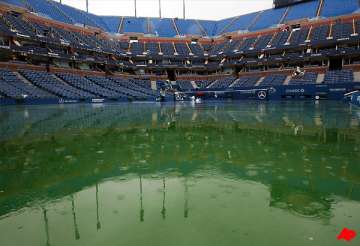Rain Postpones All Of Tuesday's US Open Matches
New York, Sept 7: On Tuesday afternoon, Rafael Nadal settled in at a table in the U.S. Open players' cafeteria and sprinkled some salt on his lunch of salmon and rice.The day's work for the

New York, Sept 7: On Tuesday afternoon, Rafael Nadal settled in at a table in the U.S. Open players' cafeteria and sprinkled some salt on his lunch of salmon and rice.
The day's work for the defending champion was complete, consisting of a 1½-hour practice session indoors at Flushing Meadows instead of his scheduled fourth-round match outdoors, because steady rain washed out all of Tuesday's action.
Sitting a couple of seats away, Toni Nadal—Rafael's uncle and coach—laughed at a question about the scary scene during a post-match news conference over the weekend, when his nephew grimaced and called for a trainer's help for right leg cramps, then slid out of his chair to the floor.
“He's perfectly healthy, with no problems at all,” Uncle Toni said. “He's good. Practice was normal yesterday, and normal today.”
During last year's run to his first U.S. Open title, which completed a career Grand Slam, Nadal served superbly—“His best serving in one tournament,” Uncle Toni called it—regularly hitting aces at more than 130 mph and getting broken a total of five times in seven matches.
This year, Nadal already was broken nine times in three matches, and six in his opener alone.
“In the first round, he played no good. He made so many mistakes. He was broken so much. But after, he played so much better,” Uncle Toni said. “I'm not worried about his serve. His serve isn't a problem.”
Indeed, their biggest concern suddenly is when the weather will allow players to get back on court. As it is, the men in the second-seeded Nadal's half of the draw—such as No. 4 Andy Murray, No. 21 Andy Roddick and No. 28 John Isner—could be forced to play four matches in five days, or even worse.
“We would prefer to play today, because after not playing today, every day is one day less,” Uncle Toni said. “That makes it more complicated.”
The men in the other half of the field, including No. 1 Novak Djokovic and 16-time major champion Roger Federer, already have progressed to the quarterfinals.
“It's a huge advantage for the top half right now. They have one match to play in the next four days, and the other guys have two—and then they'll have two more after that,” said U.S. Davis Cup captain Jim Courier, a four-time Grand Slam title winner. “It's the luck of the draw.”
There is no permanent or retractable roof on any court used for matches at the U.S. Open, unlike at Wimbledon and the Australian Open. The French Open announced plans to install a retractable roof on center court by 2016.
Citing financial concerns and technical complexities, the U.S. Tennis Association says it doesn't have plans to put a roof on Arthur Ashe Stadium, although it is still studying possible options. Past estimates put the cost of a roof at $150 million to $200 million.
And so wet weather affects plans at the year's last Grand Slam tournament, where rain pushed the men's final back a day to Monday in 2008, 2009 and 2010. The two-week U.S. Open began Aug. 29, and is scheduled to end Sunday.
Tuesday was the first time play has been delayed by rain this year, postponing a total of 54 matches—four in the fourth round of men's singles, two in the quarterfinals of women's singles, along with doubles and juniors—at least until Wednesday, when the forecast predicts more rain.
The men's matches originally set for Tuesday were Nadal against unseeded Gilles Muller of Luxembourg; Roddick, the 2003 U.S. Open champion, against No. 5 David Ferrer of Spain; Isner against No. 12 Gilles Simon of France; and three-time Grand Slam finalist Murray against unseeded Donald Young of the United States.
In women's singles, No. 2 Vera Zvonareva was to face No. 9 Sam Stosur, and No. 26 Flavia Pennetta was scheduled to play unseeded Angelique Kerber of Germany.
Those six matches now are on Wednesday's schedule, plus the other two women's quarterfinals -- 13-time major champion Serena Williams vs. No. 17 Anastasia Pavlyuchenkova, and No. 1 Caroline Wozniacki vs. No. 10 Andrea Petkovic—and the first two men's quarterfinals—Djokovic vs. No. 20 Janko Tipsarevic, and Federer vs. No. 11 Jo-Wilfried Tsonga.
“It's going to get crazy once it gets going,” Courier said.
The schedule-juggling produced a couple of notable tweaks.
Because the tournament wants to try to ensure that if tennis is played Wednesday, the held-over men's matches can get on court as early as possible, Roddick-Ferrer was shifted from Arthur Ashe Stadium on Tuesday night to Louis Armstrong Stadium at 11 a.m. Wednesday. And Young's first Grand Slam quarterfinal, against the far-more-experienced Murray, was shifted from the 23,771-seat Ashe to the 6,106-seat Grandstand.
“Donald might be more comfortable on a smaller court ... out of the spotlight,” Courier said.
Roddick hasn't played anywhere at Flushing Meadows other than Ashe since Sept. 3, 2002, when he beat Juan Ignacio Chela at Armstrong in the fourth round; that's 39 consecutive U.S. Open matches at Ashe.
Roddick acknowledges that gives him a sort of home-court advantage there.
“Yes, yes, there's definitely things that are always the same out there and things that appear to be one way and they are definitely the other way,” Roddick explained after his third-round victory Sunday. “I would sit here and go through them all, but that would pretty much waste all of the experience that you are asking me about.” AP